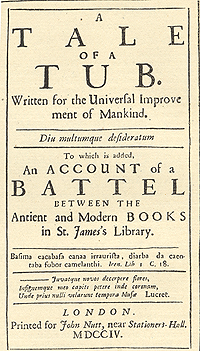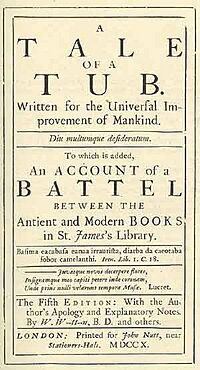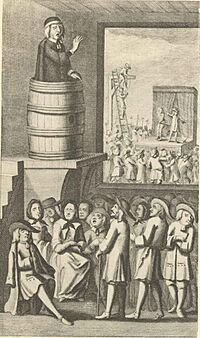A Tale of a Tub facts for kids

Cover, 1704.
|
|
| Author | Jonathan Swift |
|---|---|
| Original title | A Tale of a Tub |
| Country | Kingdom of England |
| Language | Early Modern English |
| Genre | Prose and tragedy |
|
Publication date
|
1704 |
A Tale of a Tub was the first big book written by Jonathan Swift. He wrote it between 1694 and 1697. It was published in 1704. The book is a funny story, a parody, divided into parts. Some parts are "digressions" (going off-topic). Other parts tell the "tale" of three brothers. These brothers stand for the main types of western Christianity.
The book made fun of the Roman Catholic and Anglican churches. It also made fun of other Christian groups in England. Some people thought it was against religion. For example, William Wotton said it made fun of "God and Religion." The book was still seen as an attack on religion even much later.
But the Tale was very popular. It made fun of too much religious passion. It also poked fun at how people wrote about literature, politics, and medicine back then. The main targets were being too excited, too proud, and too easily fooled. In Swift's time, politics and religion were very connected in England. So, the book's jokes about religion were also about politics. The book made Swift famous, but many people, including Queen Anne, misunderstood it. It even stopped Swift from getting a higher job in the Church of England.
Contents
What is A Tale of a Tub?
The Story of Three Brothers
A Tale of a Tub includes a main story. This story is an allegory about the Reformation. It's about three brothers named Peter, Martin, and Jack. They try to make their way in the world. Each brother stands for a main branch of Christianity.
The "tub" in the title is a play on words. Alexander Pope said "tub" was a common name for a Dissenter's pulpit. Swift himself was a clergyman.
Who are Peter, Martin, and Jack?
- Peter is named after Saint Peter. He represents the Roman Catholic Church.
- Jack is named after John Calvin. Swift also links him to John of Leiden. Jack stands for different Protestant churches. These include Baptists, Presbyterians, Quakers, and others.
- Martin is named after Martin Luther. He represents the middle way of the Church of England.
The brothers get three amazing coats from their father. These coats stand for religious practice. Their father also gives them his will, which represents the Bible. The will says they cannot change their coats. But the brothers start changing their coats right away.
The story means that the Anglican church did not change its practices. It refused to change for Puritan demands. It also kept resisting the Roman Catholic Church.
What are the "Digressions"?
After the first few sections, the book switches between "Digression" and "Tale." But the digressions become much longer. They are also more powerful and imaginative. After Chapter X, the section names get mixed up. Sections called "Tale" are actually digressions. Sections called "Digression" are also digressions.
A Tale of a Tub is a huge parody. It has many smaller parodies inside it. Many experts believe there isn't just one narrator. But most of the characters Swift uses for the parodies are very similar. Swift writes the Tale as if he is a "Modern" or "New Man." This type of person was common in Swift's time.
Swift said the book's title meant something else too. He said the "Ship of State" (the government) was in danger. It was threatened by a "whale" like the Leviathan by Thomas Hobbes. Swift's book was like a "tub" that sailors could throw overboard. This would distract the "beast" (people questioning the government). Hobbes was very controversial then. Swift might have been joking about Hobbes. The story of the brothers is not a perfect allegory. Swift's narrator is either crazy or foolish. The book could not really save the government. Swift might have been showing the dangers of Hobbes's ideas. He wanted people to think more clearly.
The digressions can be confusing. Each one has its own topic. Each is like a short essay on a side topic. Some experts think each digression is Swift pretending to be a different writer. Others think the narrator is one character. Either way, the digressions are tests for the reader. They check if the reader is smart enough to spot nonsense. Some parts, like talking about ears or wisdom, are very strange. They need a very careful reader. Each digression is a trick. Together, they teach the reader to find and reject silly ideas.
Why Did Swift Write This Book?
What Was England Like Back Then?
During the English Restoration, printing changed everything in Britain. People could easily publish their ideas as broadsheets. They could also learn about new science, literature, and politics. Books became cheaper. Summaries of new discoveries became common. The problem was telling truth from lies.
Swift wrote A Tale of a Tub as a narrator who is excited and easily fooled. This narrator thinks he is better than any writer before him. Why? Because he has new "technology" and new ideas. Swift seemed to ask: What would a person be like if they had no good judgment but loved new knowledge? The answer was the narrator of Tale of a Tub.
Swift was annoyed by people who were too eager for new knowledge. They didn't ask questions. Swift was not a fan of democracy. He saw it as "mob rule." This led to problems during the English Interregnum. Swift's satire aimed to help. It showed what bad writers were like.
In Swift's England, politics, religion, and education were all linked. The king or queen was the head of the church. Schools had political traditions. The two main groups were linked to religious and economic groups. If you were not for the Church, you were seen as not for the monarch. Being interested in science and trade was linked to dissenting religions. It was also linked to the Whig Party. When Swift attacked those who loved all things modern, he was also attacking new trade, dissenting religions, and parts of the Whig Party.
Swift's Background and Ideas
Jonathan Swift was born in Ireland to English parents. He wrote A Tale of a Tub (1694–1697) while working for Sir William Temple. The book was published when Swift left Temple's service. He had given up hope of getting a good job from Temple.
The "Tale" was part of an argument Temple was having. Swift's main point was about the "Quarrel of the Ancients and the Moderns." This was a French debate from the early 1690s. Fontenelle said modern learning was better than ancient knowledge. Temple disagreed. He said modern critics only see more because they are "dwarfs standing on the shoulders of giants." Two men who disagreed with Temple were Richard Bentley and William Wotton.
The debate in England was over by 1696. But it still inspired Swift. He saw the "Ancients" and "Moderns" as two ways of looking at the world. The Tale of a Tub attacks anyone who praises modern ideas over classical learning. Temple did this too. But Swift did not praise the classical world either. Some people think this shows Swift disliked all people. Others think it shows he hated pride.
The Tale brought the "Quarrel" back to life. Wotton even wrote a new edition of his pamphlet attacking Temple. He added an essay against the author of A Tale of a Tub. Swift used parts of Wotton's "Answer" as "Notes" in the fifth edition of the Tale. This made the commentary part of the satire itself.
Swift believed the book cost him a high position in the church. But he probably wanted to become a literary and political figure. He wanted to get noticed by important men. And he did. Because of this book, Swift became friends with Robert Harley and Henry St. John. When the Tories came to power in 1710, Swift was rewarded. But by 1713–14, the Tory government fell. Swift was made Dean of Saint Patrick's Cathedral, Dublin. He felt this was like being sent away.
How Was the Book Published?
The Tale was first published in 1704 by John Nutt. Swift usually used Benjamin Tooke. He would use Tooke again for the fifth edition (1710) and later books. Tooke's successor, Benjamin Motte, published Swift's Gulliver's Travels.
The first, second, and third editions of the Tale came out in 1704. The fifth edition followed in 1710. Swift said he gave his publisher a rough copy of the book. He kept a messy copy himself. He also lent copies to others, including his cousin, Thomas Swift. So, the first edition had many mistakes. The second edition fixed some of these. The third was a reprint of the second with more corrections. The fourth corrected the third.
The fifth edition of 1710 was the first truly new one. This is the version most modern editors use. It was in this edition that the Notes and the "Apology for the &c." were added. Many readers at the time found this made the satire even stronger.
Who Really Wrote A Tale of a Tub?
Today, there's little debate about who wrote the Tale. But in the 18th and 19th centuries, many famous critics wondered. Samuel Johnson said A Tale of a Tub was a work of true genius. He thought it was too good to be Swift's. Many 19th-century critics saw Swift's later work as angry or mad. They wanted to say he didn't write the Tale. How a critic felt about the author often showed their own politics. Swift was a strong supporter of Tory ideas. So, people who liked the Tale but not Swift's politics often wanted to say someone else wrote it.
The book came out anonymously in 1704. Swift often published anonymously. This protected his career and himself. As a churchman, Swift needed support from nobles to get a good job. Nobles were also in charge of Church matters in the House of Lords. So, his political power depended on them.
The Tale was popular and controversial right away. People guessed who wrote it. Jonathan Swift was not widely known then. Some thought William Temple wrote it. Francis Atterbury heard people at Oxford thought Edmund Smith and John Philips wrote it. But he thought it was Jonathan Swift. Some even thought Lord Somers wrote it.
Jonathan Swift had a cousin, Thomas Swift, who was also a churchman. They wrote letters to each other when the Tale was being written. Thomas Swift later said he wrote the book. Jonathan said Thomas only wrote very small parts. He said he would like to hear Thomas "explain" the book if he wrote it. The confusion grew because of the publisher choice. Swift used Tooke before and after the Tale. So, it was unusual for John Nutt to publish it.
But the style and feelings in the Tale are clearly Swift's. The way he pretends to be a character and makes fun of writing styles is typical of him. Thomas Swift left very few other writings. Experts like A. C. Guthkelch and D. Nichol Smith said that all the proof for Thomas Swift's part in the Tale was "nothing but rumour."
Robert Hendrickson wrote that Swift always loved his original book, The Tale of a Tub. Later in life, after reading it again, Swift supposedly said, "Good God! What a genius I had when I wrote that book!"




